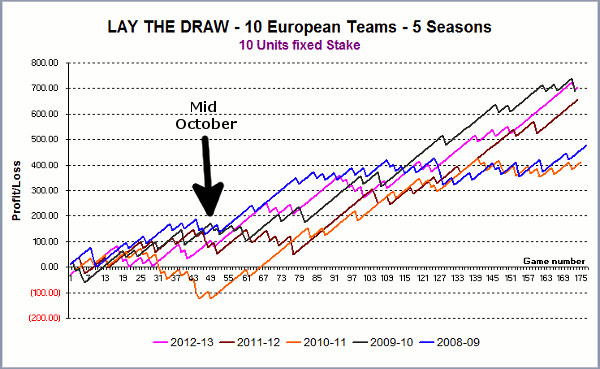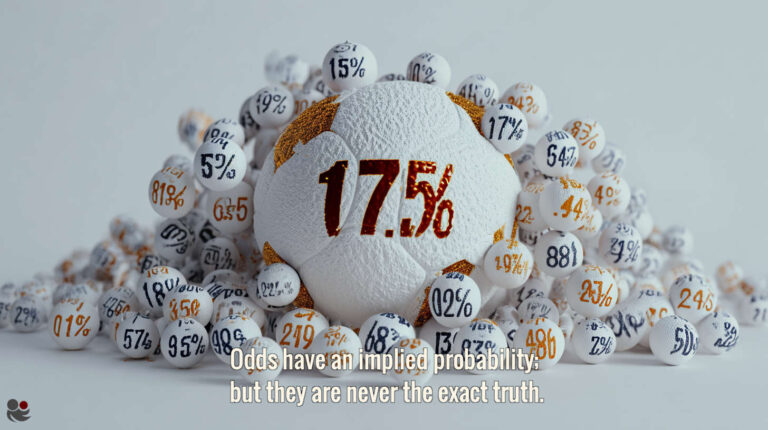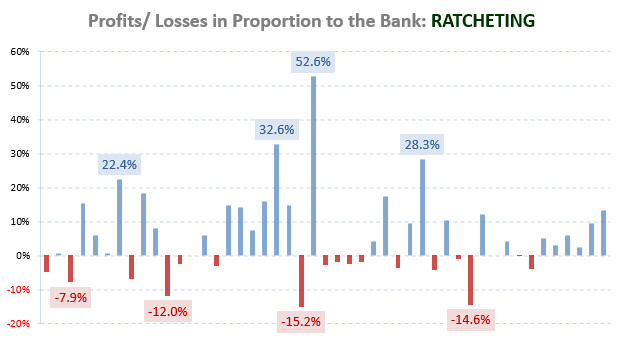
<strong>Lay the Draw - 5 seasons - fixed stake</strong> (<a href='https://www.soccerwidow.com/betting-maths/techniques/1x2-betting-system-strategy-lay-the-draw/'>1×2 Betting System: Analysis of HDA Data and Strategy Development</a>)
If you are not operating a football betting portfolio which is primarily aimed at diversifying risk and balancing your cash resources between different leagues, matches, and outcomes, then it is strongly advisable to hold off from any betting at the very start of a season.
The Effects of a Break
After the break between seasons there are usually many changes observed in teams. The manager may have changed; the playing staff may have shuffled; the team could even be playing in a different league, etc.
Undoubtedly, three months’ ‘holiday’ must have an effect on super-fit professional footballers – After all, even millionaires are humans!
Just reflect on yourself…
- Are you usually in full working order when you return to work after a long break?
- How long does it take you to get back into your routines at work?
- How often have you experienced changes in staffing, organisational structure, etc., after you returned to work?
Unexpected Results and Deviations at the Start of Season
It does not matter which betting system or value betting approach is monitored, there are usually many matches observed at the start of a season finishing with unexpected results and not within statistical expectations.
It usually takes approximately six weeks to two months, until teams “settle” statistically and begin following averages from previous seasons.
Here is a screenshot from the Lay the Draw system explained in my article 1×2 Betting System: Analysis of HDA Data and Strategy Development – LAY THE DRAW…

1×2 Betting System: Analysis of HDA Data and Strategy Development
The image above shows a deficit at the start of the 2010-11 season, which persisted until mid October.
The other four seasons finished with profits around the 100 unit mark, but to gain this level of profit 50 bets were needed, translating to an average loss/win of between minus two and plus two units per bet.
The remaining 120 bets (from mid October to mid May) produced profits between 300 and 500 units which averages a win of between 2.5 and 4.2 units per match. This is not only more efficient but also easier on the nerves.
To bet and win consistently depends on the portfolio structure and betting strategy. Some systems may stabilise after the first six weeks, others may need six rounds of home matches, for example. Each strategy needs to be assessed individually.
Bookmaker Primary Aim – Diversify Risk and Balance the Book
It may appear that bookmakers don’t seem to worry too much about the start of a new football season. They invariably publish their odds far in advance of the games.
Indeed, how would the market react if bookies offered no bets during the first few weeks of a season?
To counter the unpredictability of results and the deviation from statistical expectations at the start of a season bookmakers ensure they offer odds which balance their books even if it is more of a juggling act than usual.
In summary, to bet and win consistently it is necessary to have a reliable portfolio, synchronised with the most advantageous betting time for optimum performance. Fluctuations within a season need to be taken into consideration.
It is crucial to construct a football betting portfolio which is large enough to diversify risk.








Hi,
Would you recommend always holding off betting til the season is six weeks to two months in, even if this means I have to deviate from my betting system that is based on HDAFU simulation tables?
Best regards
John
Hi John, you have to look at the betting system you derived from the tables, see how it performed in the past for the first six weeks/ two months of a season. Sometimes, they perform well, sometimes not.
Bookmakers use historical data when setting odds, and after a longer break, teams may change. A quite prominent example is Man Utd after Alex Ferguson left. A team which was winning most of their games season after season, stopped winning all of a sudden.
Once the season starts, and a few games have been played, then a correction factor can be applied, and the new stats are taken into account. The ‘normal’ calculations of the bookmakers stabilise, e.g. under-pricing the publicly perceived favourite. But if the past true favourites are still favourites, this may change withing the first few weeks.
The above strategy is completely wrong. That’s because the games of the principle of each season is the only time that a player and bookmaker begin their struggle from the same location. This is because that information is in the hands of the player, but so is the man who puts the odds. And these figures are theoretical, meaning that both have the same chance of being wrong.
When ‘scrolling’ leagues, numerical and qualitative data available, can apparently show that the job of the players will be easier to identify points, but should not ignore the fact that these elements is available and bookmaker and you must accept that he has stronger tools from you to process all this data.
The graph refers to a portfolio of “lay the draw” bets for 10 individually picked teams from 10 different European.
I explained the selection criterias in the article: 1×2 Betting System: Analysis of HDA Data and Strategy Development – LAY THE DRAW
All selected teams possess a clear tendency to produce far less draws than the league averagres, and therefore there draw odds are consistently underpriced and produce a constant lay profit, but not until mid October. The first two months of their new seasons they draw more often than they usually do and therefore without a substantial profit for people using this system.
Does that graph shows more tendency to draws before mid october?
From what I just read here, it means the start of a season it’s even riskier, personally I’ll wait some weeks to see how is it going, and how the bookmakers refine their odds. Honestly I’ll refrain a bit from my original plan, but I’ll follow your advice, so thanks for sharing this info.
The unexpected results and not within statistical expectations are basically due to fitness & form not being at their best yet, however I found some big value bets according to the Value Detector; some won some lost, but far away from being a complete disaster; if there were not other elements involved besides statistics and pure mathematics this could be much easier!…obviously I’ll stick to a more conservative approach during these weeks from now on.